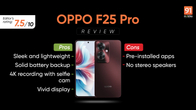
The OPPO AirVOOC is the company’s first wireless charging solution and is claimed to charge a device fully (with a 4,000mAh battery) in just 56 minutes. It is said to deliver 1-hour standby time with just 5 minutes of charging. The device comes with air-cooling technology for proper heat dissipation and Qi wireless charging standards, making it compatible with a wide range of phones and earphones that have wireless charging support. It is equipped with a self-developed high-voltage isolated charging pump that is claimed to block potential DC paths so the voltage and current that could be harmful to the battery cannot reach the battery cell.
OPPO’s AirVOOC adopts dual cells in series structure, which only requires one voltage reduction and generates less heat in return, with a conversion efficiency of up to 98 percent. It has Butterfly Wing air-cooling technology, where the maximum temperature of the back of the mobile phone can be maintained below 39℃ while charging. There’s also a low power operation ‘Smart Mute’ mode that enables silent nighttime charging and improves efficiency. The special mode also allows users to manually set periods for the low-power operation to achieve optical usage and charging efficiency.


















